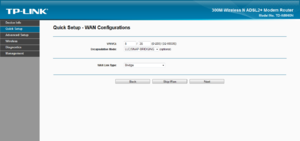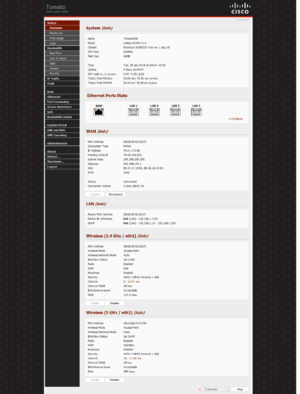We are still actively working on the spam issue.
Routers
A router is a device that route packets between different devices and networks.
Modern residential routers don't only route packets, but also offer several advanced features, like a firewall, QoS, packet filtering, DHCP and more. It's also common for routers to incorporate an access point, to provide wireless connectivity.
Please note that a home router is not an actual router: it typically will not have any routing capability. A home router is a combination of a NAT (Network Address Translation) gateway, a switch and a DHCP server.
Contents
Modem
A modem is a simple device that convert a digital signal to an analog one, and vice versa. One is usually needed to connect to the Internet.
It's hard to find a modem by itself nowadays, most are sold as a modem/router combo. While those combos are nice, since you only need to run a single devices, they aren't usually supported by third party firmwares (the only exception being some router/modem combo using a Lantiq chipset, which are supported by OpenWRT), and are overpriced compared to standalone routers.
"Bridge mode" is used to "disable" the router part in those, and use them as standalone modems with a separate, standalone router.
For ADSL, modem using recent Broadcom chipset usually give the most stable/faster connection.
Many Internet Service Providers in the US provide a modem with their service, but it is usually shit. You may want to ask them for a list of approved modems before buying your own, but bear in mind that this list may just include companies that pay in order to get on that list.
Aftermarket antennas
Changing the antennas in your router is a quick way to improve the strength of the wireless connection. Note that while it usually help, it depends on a lot of factors. Changing the antennas could double your signal strength, or it might not improve anything. The only way to know for sure it's to try.
Routers usually come with 3db antennas. Aftermarket ones go up to 12db, and even more.
Routers also usually comes with omnidirectional antennas. Those are great since they send the signal in every direction, but if you need to reach only some specific point, mono/bidirectional antennas are better for that.
To change your antennas, you need to know what connector your router is using. The most common one is RP-SMA, but doublecheck on the router specification page too. If that page doesn't say anything, here's a great cheatsheet with the most common adapter.
When replacing the antennas, remember that you need to change every antennas your router has. Not changing them all will not provide any benefit, and might lower your signal strength.
When shopping for an aftermarket antenna, don't go too cheap. Cheap ones are "up to Xdb", which mean that it might go up to Xdb, but it probably will not.
Another solution to consider for improving signal strength is to get a better adapter. Sometimes you can't just do anything from your router, but you need a good adapter with a good external antenna.
Third party firmwares
Tomato
Tomato is a custom firmware known for its simple and user friendly interface.
There are several forks of Tomato, and it's recommended you use them instead as they're much more up to date, the most famous being:
- Tomato by Shibby it's the most featureful one. The major features include a Torrent client (Transmission), Tor support, DNSCrypt support and miniDLNA.
- AdvancedTomato based on Tomato by Shibby, but uses a new interface.
- Tomato by Toastman Barebone version, if you think that your router should only route packets, and do that the best it can.
- Tomato RAF It's the version that supports more routers than everyone else. If your router is not supported by any other version, check this one.
- Tomato USB Supports a few routers that other variants do not. (Tomato USB is no longer developed, there will be no more releases) (The last version of TomatoUSB was Build 54 - dated 11/30/2010)
While there are many forks, their developers constantly share code. Because of this, it's hard to find a feature that is supported by only a specific version of Tomato.
OpenWRT
The OpenWRT wiki is not always updated, so when checking if your router is supported, always search in the forum too.
- Bufferbloat-CeroWRT Based on OpenWRT but with tweaks that makes it be so much more responsive and supports IPv6. Basically the testbed for people wanting the cutting edge of network research. Currently only works on a very limited set of hardware of NetGEAR (WNDR 3700v1/2, 3800 and WNDR Mac)
- OpenWireless Based on CeroWRT, but with emphasize on ease of use for creating open access guest networks.
- Gargoyle Based on OpenWRT, has a little bit more advanced interface that can track individual IP traffic. Works mainly on AR71XX line.
DD-WRT
http://desipro.de/ddwrt/K3-AC-Arm/ DD-WRT fork(?) that support the latest ARM routers (Netgear R6250/R6300v2/R7000, Asus AC56U/AC68U, D-Link DIR-868R)
Asuswrt-merlin
Asuswrt-merlin (Download) is a custom firmware based on Asuswrt, the opensource firmware used by recent Asus routers.
It supports the following models: RT-N16, RT-AC56U, RT-N66U, RT-AC66U, RT-AC68U.
Since it's based on Asuswrt, it uses the official webui, while adding several useful features, like SSH access, Cron jobs, customizable user scripts and several minor tweak/enchantments (full list here).
Gargoyle
Supports TP-Link TL-WR1043ND and others.
RouterTech AR7
Custom firmware, with sources for Texas Instruments AR7 (Class II) based routers, except the Netgear DG834 (which is rather different but has an OpenWRT port, unlike the other AR7 modem/routers)
Updates to latest BusyBox versions and adds SSH and useful shell utils (top and netstat for example) along with some RAM optimization routines, better QoS, newer DSL datapump drivers for ADSL, better monitoring, etc, etc.
Use a computer as a router
If you have a spare computer around, or you need more power than a small arm/mips cpu can give you, then you can turn your computer into a router.
pfSense is the most common distribution used, and it's based on FreeBSD. A Linux-based alternative is Smoothwall
The advantages of running a computer as your router are:
- More powerful CPU, useful to run various services on it (normal routers choke when running a torrent client at high-speed, or a full webserver).
- Price, it's free or almost if you already have a spare computer around
The disadvantages are:
- Noise. Unless you build a passive-cooled system, you'll have fans running all the time.
- Low-power x86 processors (such as Intel Atom or AMD Geode) can be passively cooled.
- Power consumption. Routers use around 5-10W, while a full computer can use much more. If you have a pentium4 around, you can double that as a free heater.
- Low-power x86 processors are not significantly more power hungry than ARM. Though they do require more power, which is something to consider if you wish to maintain an active internet connection when the power goes out.
- Price. If you don't have a spare computer, then building one can be more expansive than just getting a router.
- Atom boards can often be found on Ebay or other such sites for a low price.
Adblock script?
Can be used with tomato-based firmwares, don't know if it works on DD-WRT.
Follow this thread.
If you happen to be a poorfag with a router with less than 4MB Flash and had to have a "lite" version of the firmware, the adblock.sh script won't work. In those "lite" versions, awk is not installed. If that's the case, or you don't have a JFFS partition, you can get an all-in-one adblock script that you can copy pasta to the WAN-Up section of Tomato here.
What routers does /g/ recommend?
WRT54GL
The classic "little blue box" small office/home office router. This device was and still is what sits between many people and the internet. It has aged well, and provides speeds most SOHO networks won't ever really need to fully exploit. Also puts out wireless G, which while not as fast as N, is adequate. Linksys programmed the WRT54G's firmware off GPL code, and open sourced that firmware. The result of this open sourcing is the creation of OpenWRT and DD-WRT.
Features
- Four 100Mbps Fast Ethernet switchports
- One 100Mbps Fast Ethernet WAN port
- Wireless B/G connectivity
- DD-WRT is the default firmware
ASUS RT-N66U
The new powerhouse router. If you need gigabit speeds throughout your network in both wired and wireless connections this is the one to get. It comes with it's own firmware but is easily flashed to DD-WRT or TomatoUSB. You may not be able to find the RT-N66U and can find the RT-N66R. The difference between the U and R is the R is designed for retailers. The hardware is exactly the same.
Features
- 2.4 GHz and 5 GHz Concurrent Dual-Band Transmissions
- ASUS AiCloud service ( Access your shit inside the network from outside the network, by default is disabled. See also: Botnet )
- 4 Gigabit LAN ports
- 1 Gigabit WAN port
- Wireless B/G/N Connectivity ( ASUS RT-AC66U provides B/G/N/AC )
TP-Link TL-WR741N/ND
TP-Link provides a broad variety of budget routers with the TL-WR741N/ND being the cheapest. Costing as little as 20$ this router is your best bet if you're low on money. Since it is greatly supported by open firmwares like DD-WRT and OpenWRT the lack of features of the original firmware can be easily compensated. Furthermore the TL-WR741ND has an unpopulated USB 2.0 port that can be made use of. You might also want to have a look at the TL-WR841N/ND which is slightly more expensive, but comes with two antennas and 300 Mbps wifi instead of 150 Mbps.
Features
- Four 100Mbps Fast Ethernet switchports
- One 100Mbps Fast Ethernet WAN port
- Wireless B/G/N connectivity
- Detatchable antenna (TL-WR741ND only)
- Good open firmware support
- USB 2.0 port (soldering and a few parts needed)
NetGEAR WNDR 3800
This is the all-around good router that is officially supported by CeroWRT as well as OpenWireless. More to come later.
Cisco ASA5505
This is a hardware firewall that can act as an edge router. This will not have any wireless features with it as its just an firewall. [1] This device can be configured as strict as you want and as not strict. This device will not work out of box and requires a bit of knowledge to get things working correctly. There is a GUI for this device that can be used to get all of the information as there is a lot of information that requires correlation between config parts.

